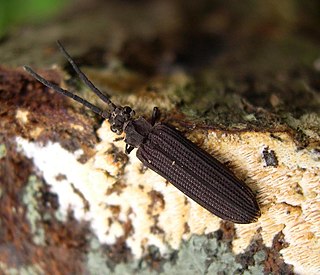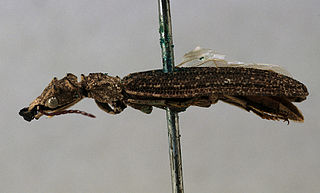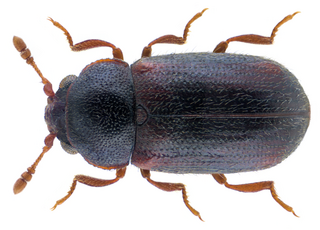
The Cupedidae are a small family of beetles, notable for the square pattern of "windows" on their elytra, which give the family their common name of reticulated beetles.

Nosodendridae is a family of beetles, with less than a hundred species in three extant genera, which are found worldwide. Nosodendron, the largest genus, is found in forests and attracted to yeast generated slime on the wounds of trees, and likely consumes fermented substances as well as fungi and microorganisms. Several additional genera and species are known from the fossil record. Nosodendridae is considered to be an isolated lineage within Polyphaga, being the sister group to the clade containing Staphyliniformia, Bostrichoidea and Cucujiformia.

The Ommatidae are a family of beetles in the suborder Archostemata. The Ommatidae are considered the extant beetle family that has most ancestral characteristics. There are only seven extant species, confined to Australia and South America. However, the geographical distribution was much wider during the Mesozoic spanning across Eurasia and Australia, suggesting that they were widespread on Pangea. So far, over 26 extinct genera containing over 170 species of these beetles have been described. Three extant genera have been assigned to this family: Omma,Tetraphalerus and Beutelius. The family is considered to be a subfamily of Cupedidae by some authors, but have been found to be more closely related to Micromalthidae in molecular phylogenies. A close relationship with Micromalthidae is supported by several morphological characters, including those of the mandibles and male genitalia. Due to their rarity, their ecology is obscure, it is likely that their larvae feed on deadwood.

Sphindidae is a family of beetles, in the suborder Polyphaga. They are called slime mold beetles due to their exclusive feeding on slime molds during adult and larval stages, other aspects of their life history are obscure. Palaeontological discoveries since 2015 have added to the geologic history of Sphindidae, including the discovery of Libanopsis, placed in the extinct subfamily Libanopsinae.
Eurydictyon is an extinct genus of beetle in the family Ommatidae which contains a single species, Eurydictyon conspicuum. E. conspicuum lived during the Pliensbachian stage of the Early Jurassic, between 189.6 and 183.0 Ma. It measured 18 x 8 mm in length and is known only from specimens found in Kyrgyzstan. Eurydictyon may be closely related to the genus Notocupes.
Notocupoides is an extinct genus of beetles in the family Ommatidae, known from the Carnian Madygen Formation of Kyrgyzstan, containing the following species:
Zygadenia is an extinct genus of archostematan beetles from the Jurassic to Cretaceous. It is considered to be a senior synonym of Notocupes by Kirejtshuk (2020), but other researchers suggest to reserve the genus Zygadenia as a form taxon for isolated elytra that probably belong to the genus Notocupes, while retaining Notocupes as a valid genus for complete body fossils.

Omma is a genus of beetles in the family Ommatidae. Omma is an example of a living fossil. The oldest species known, O. liassicum, lived during the final stage of the Triassic (Rhaetian), over 200 million years ago, though the placement of this species in Omma has been questioned. Numerous other fossil species are known from the Jurassic and Cretaceous of Europe and Asia. The only living species is Omma stanleyi, which is endemic to Australia. Three other extant species endemic to Australia that were formerly part of this genus were moved to the separate genus Beutelius in 2020.Omma stanleyi is strongly associated with wood, being found under Eucalyptus bark and exhibiting thanatosis when disturbed. Its larval stage and many other life details are unknown due to its rarity. Males are typically 14–20 mm in length, while females are 14.4-27.5 mm. Omma stanleyi occurs throughout eastern Australia from Victoria to Central Queensland.

Eucnemidae, or false click beetles, are a family of elateroid beetles including about 1700 species distributed worldwide.

The Protocoleoptera are a paraphyletic group of extinct beetles, containing the earliest and most primitive lineages of beetles. They represented the dominant group of beetles during the Permian, but were largely replaced by modern beetle groups during the following Triassic. Protocoleopterans typically possess prognathous (horizontal) heads, distinctive elytra with regular window punctures, culticles with tubercles or scales, as well as a primitive pattern of ventral sclerites, similar to the modern archostematan families Ommatidae and Cupedidae. They are thought to have been xylophagous and wood boring.
2019 in paleoentomology is a list of new fossil insect taxa that were described during the year 2019, as well as other significant discoveries and events related to paleoentomology that were scheduled to occur during the year.
2020 in paleoentomology is a list of new fossil insect taxa that were described during the year 2020, as well as other significant discoveries and events related to paleoentomology that were scheduled to occur during the year.
Echinocups is an extinct genus of ommatid beetle. It was created in 2020 to house three species originally assigned to Notocupes, E. denticollis, E. neli and E. ohmkuhnlei The genus name refers to the sharp spikes present on the elytra. All three species are known from the Cenomanian aged Burmese amber of Myanmar. The status of Echinocups as a distinct genus was contested by Li et al. (2023), who considered the genus Echinocups to be a junior synonym of the genus Notocupes.
Burmese amber is fossil resin dating to the early Late Cretaceous Cenomanian age recovered from deposits in the Hukawng Valley of northern Myanmar. It is known for being one of the most diverse Cretaceous age amber paleobiotas, containing rich arthropod fossils, along with uncommon vertebrate fossils and even rare marine inclusions. A mostly complete list of all taxa described up until 2018 can be found in Ross 2018; its supplement Ross 2019b covers most of 2019.
This paleoentomology list records new fossil insect taxa that were to be described during the year 2021, as well as notes other significant paleoentomology discoveries and events which occurred during that year.

Limnomma is an extinct genus of ommatid beetle from the Middle Jurassic of China. The type and only known species Limnomma daohugouense is known from the Bathonian aged Daohugou Beds of Inner Mongolia, China.
This paleoentomology list records new fossil insect taxa that are to be described during the year 2022, as well as notes other significant paleoentomology discoveries and events which occurred during that year.
This list of 2023 in paleoentomology records new fossil insect taxa that are to be described during the year, as well as documents significant paleoentomology discoveries and events which occurred during that year.
Lepidomma is an extinct genus of ommatid beetle. The genus was first described in 2019 for the species L. tianae. Lepidomma was synonymised with Clessidromma by Kirejtshuk, 2020. This synonymy was disputed by Li et al. (2021), who maintained Lepidomma as a separate genus from Clessidromma. Three additional species of Lepidomma were described in 2020 and 2022. All four species are known from the Cenomanian aged Burmese amber of Myanmar.

Notocupes is an extinct genus of medium-sized archostematan beetles from the Mesozoic Era of Eurasia, including over 50 described species. Historically, the genus was classified as a member of the family Ommatidae, but the presence of characters such as the horizontal mandibular cutting edge, separated procoxae and overlapping abdominal sternites indicate that the genus may have a closer affinity with the family Cupedidae. Notocupes is considered to be a junior synonym of Zygadenia by Kirejtshuk (2020), but other researchers suggest to reserve the genus Zygadenia as a form taxon for isolated elytra that probably belong to the genus Notocupes, while retaining Notocupes as a valid genus for complete body fossils. Most species of Notocupes were described from compression fossils. An additional three species were described from Cenomanian-aged Burmese amber, which were treated as a separate genus, Echinocups, by Kirejtshuk (2020), but Li et al. (2023) consider Echinocups to be a junior synonym of Notocupes. Notocupes has a flattened body, which may suggest that it occupied narrow habitats, such as living under bark. Some species had serrated/spined margins of the carapace, which may have served as a defense against predators, or served as camouflage to resemble bark.








